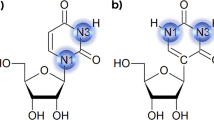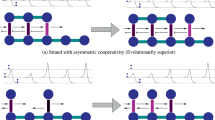Abstract
A nonpolar aromatic nucleoside derivative based on 2,4-difluorotoluene (F), a non-hydrogen bonding shape analog of thymidine, was recently shown to be replicated against adenine with high efficiency and fidelity. This led to the suggestion that geometric matching, potentially even in the absence of hydrogen bonding between bases in a pair, may be sufficient to direct nucleotide selection during replication. We have examined the solution structure of the F–A pair in the context of a 12 base pair DNA duplex. We find that, despite the destabilization caused by this analog, the F–A pair very closely resembles that of a T·A pair in the same context. This lends support to the importance of shape matching in replication.
This is a preview of subscription content, access via your institution
Access options
Subscribe to this journal
Receive 12 print issues and online access
$189.00 per year
only $15.75 per issue
Buy this article
- Purchase on Springer Link
- Instant access to full article PDF
Prices may be subject to local taxes which are calculated during checkout



Similar content being viewed by others
Accession codes
References
Lesser, D.R., Kurpiewski, M.R. & Jen-Jacobson, L. Science 250, 776– 786 (1990).
Brennan, C.A., Van Cleeve, M.D. & Gumport, R.I. J. Biol. Chem. 261, 7270– 7278 (1986).
Seela, F. & Driller, H. Nucleic Acids Res. 14 , 2319–2332 (1986).
Ono, A., Sato, M., Ohtani, Y. & Ueda, T. Nucleic Acids Res. 12, 8939–8949 ( 1984).
Newman, P.C. et al. Biochemistry 29, 9891– 9901 (1990).
Aiken, C.R. & Gumport, R.I. Meth. Enz. 208, 433–457 (1991).
Smith, S.A., Rajur, S.B. & McLaughlin, L.W. Nature Struct. Biol. 1, 18– 22 (1994).
Schweitzer, B.A. & Kool, E.T. J. Org. Chem. 59, 7238–7242 (1994).
Chaudhuri, N.C., Ren, X.F.R. & Kool, E.T. SYNLETT, 341–347 (1996).
Moran, S., Ren, X.F.R. & Kool, E.T. J. Am. Chem. Soc. 119, 2056– 2057 (1997).
Moran, S., Ren, X.F.R. & Kool, E.T. Proc. Natl. Acad. Sci. USA 94, 10506–10511 (1997).
Schweitzer, B.A. & Kool, E.T. J. Am. Chem. Soc. 117, 1863–1872 ( 1994).
Guckian, K.M. & Kool, E.T. Angew. Chem. Int. Ed. 36, 2825–2828 (1998).
Harley, V.R., Lovell-Badge, R. & Goodfellow, P.N. Nucleic Acids Res. 22, 1500 –1501 (1994).
Leroy, J.L., Kochoyan, M., Huynhdinh, T. & Gueron, M. J. Mol. Biol. 200, 223–238 (1988).
Gueron, M. & Leroy, J.L. Meth. Enz. 261, 383–413 (1995).
Baleja, J.D., Pon, R.T. & Sykes, B.D. Biochemistry 29, 4828– 4839 (1990).
Gronenborn, A.M. & Clore, G.M. Biochemistry 28, 5978–5984 (1989).
Clore, G.M., et al. Biochemistry 27, 4185– 4197 (1988).
Gorenstein, D.G. 31P NMR of DNA. Meth. Enz. 211, 254–286 (1992).
Borgias, B.A. & James, T.L. J. Magn. Reson. 87, 475–487 (1990).
James, T.L. Curr. Opin. Struct. Biol. 1, 1042– 1053 (1991).
Schmitz, U. & James, T.L. Meth. Enz. 261, 3–44 (1995).
Meyer, M. & Suhnel, J. J. Biomol. Struct. Dyn. 14, 117 (1997).
Guckian, K.M. et al. J. Am. Chem. Soc. 118, 8182– 8183 (1996).
Rastinejad, F., Evilia, C. & Lu, P. Meth. Enz. 261, 560–576 (1995).
Chaudhuri, N.C. & Kool, E.T. Tetrahedron Lett. 36, 1795–1798 ( 1995).
Huang, G. & Krugh, T.R. Anal. Biochem. 190, 21–25 (1990).
Freier, S.M., Burger, B.J., Alkema, D., Neilson, T. & Turner, D.H. Biochemistry 22, 6198– 6206 (1983).
Petersheim, M. & Turner, D.H. Biochemistry 22, 256–263 ( 1983).
Ferrin, T.E., Huang, C.C., Jarvis, L.E. & Landgridge, R. J. Mol. Graphics 6, 13–27 (1988).
Huang, C.C., Pettersen, E.F., Klein, T.E., Ferrin, T.E. & Landgridge, R. J. Mol. Gaphics 9 , 230–236 (1991).
Acknowledgements
We thank the NIH for support. We thank M. Fountain for many helpful discussions.
Author information
Authors and Affiliations
Corresponding authors
Rights and permissions
About this article
Cite this article
Guckian, K., Krugh, T. & Kool, E. Solution structure of a DNA duplex containing a replicable difluorotoluene–adenine pair. Nat Struct Mol Biol 5, 954–959 (1998). https://doi.org/10.1038/2930
Received:
Accepted:
Issue Date:
DOI: https://doi.org/10.1038/2930



